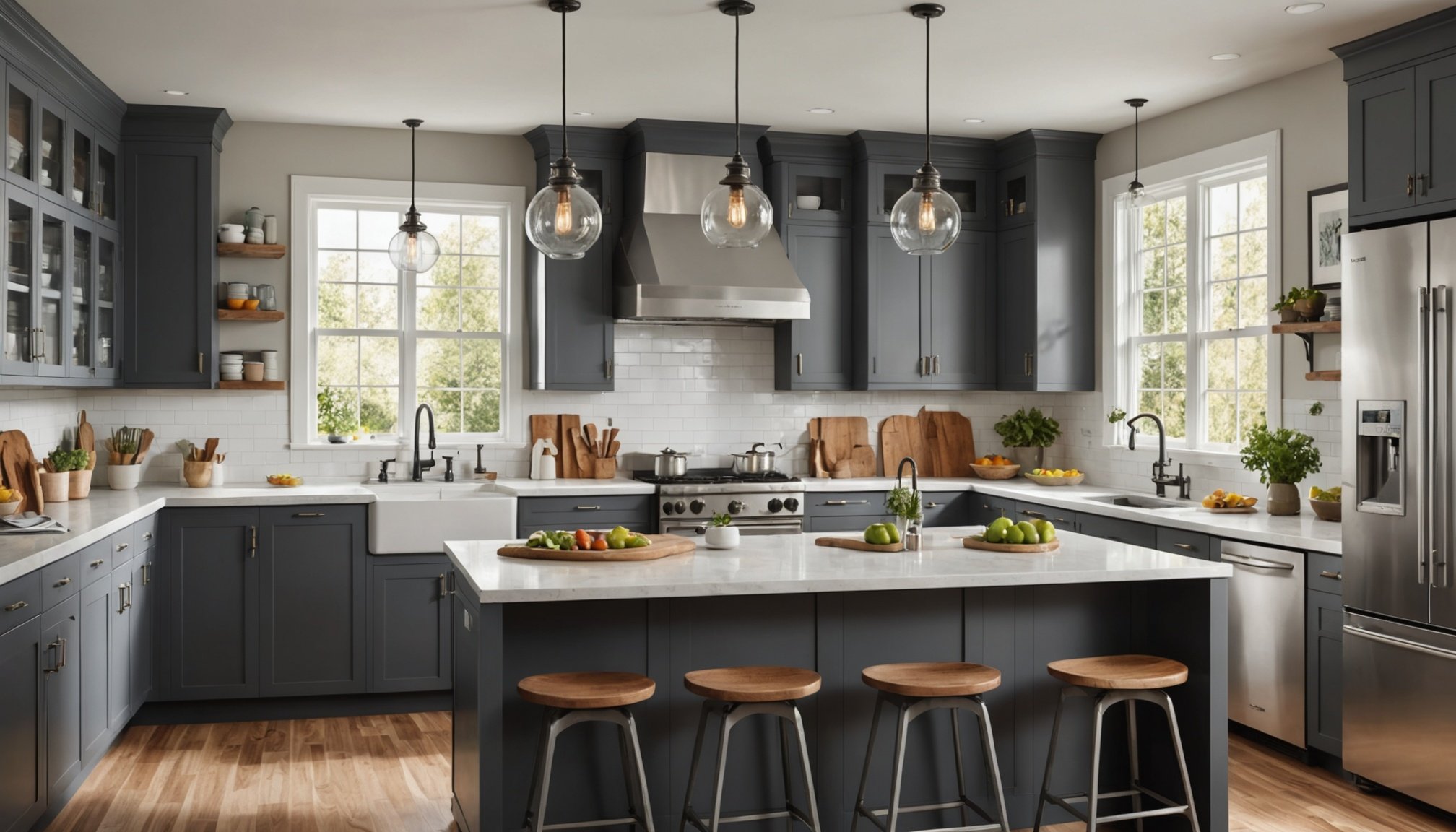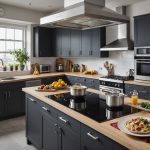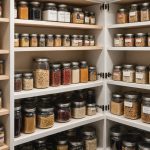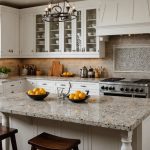Transforming Your Kitchen into an Allergy-Free Haven: Cutting-Edge Design Ideas for a Healthier Lifestyle
Creating an Allergen-Safe Environment: Essential Tools and Gadgets
When it comes to transforming your kitchen into an allergy-free haven, the right tools and gadgets are crucial. These tools not only ensure safety but also make cooking more efficient and enjoyable.
Color-Coded Cutting Boards: A Must-Have for Cross-Contamination Prevention
Color-coded cutting boards are a fundamental component of an allergen-safe kitchen. These boards help prevent cross-contamination by designating different colors for specific foods, such as proteins, vegetables, and allergenic ingredients like nuts or dairy. For example, you can use a red board for meats, a green board for vegetables, and a yellow board for allergens. Dishwasher-safe materials like silicone or stainless steel ensure quick and thorough cleaning, which is vital for maintaining an allergen-free kitchen[1].
Also to see : Discover Effortless Pantry Organization: Transform Your Space with Sliding Shelves!
Stand Mixers and Multi-Functional Cookers: Time-Saving and Versatile
A stand mixer is a versatile kitchen tool that can handle everything from bread dough and cookie batter to mashed potatoes, leaving you hands-free to prepare other dishes. Similarly, an Instant Pot or slow cooker is perfect for preparing stews, soups, and even desserts, simplifying the process of creating multiple allergen-safe courses during the festive season. These gadgets are not just time-savers but also ensure that your kitchen remains efficient and safe[1].
Air Fryers and Food Processors: Healthy and Efficient Cooking
An air fryer is an excellent tool for preparing healthy holiday snacks with minimal oil, making it a perfect way to create allergen-friendly versions of crowd favorites like roasted nuts, vegetable fries, or gluten-free pastries. A food processor, with its ability to chop, puree, and shred, reduces prep time significantly, especially for large meals. From smooth dips and pastes to finely chopped vegetables, this gadget is an indispensable ally for allergy-conscious cooks[1].
Topic to read : Enhancing Cooking Safety: Cutting-Edge IoT Solutions for a Secure Kitchen Experience
Designing Your Kitchen for Maximum Safety and Efficiency
Beyond the tools and gadgets, the design of your kitchen plays a critical role in creating an allergy-free haven.
Simple and Functional Kitchen Design
A simple kitchen design can make your space feel more organized and efficient. Consider a horizontal kitchen design, which can add a touch of elegance and depth to your space. Wooden kitchen cabinets with horizontal white accents and a traditional countertop can enhance both the aesthetics and functionality of your kitchen. This design ensures that your kitchen remains neat and organized without compromising on style[2].
Utilizing Natural Light
Natural light is a powerful design element that can make your kitchen more welcoming and vibrant. Strategic placement of large windows and well-positioned mirrors can maximize the use of natural light, reducing the reliance on artificial lighting during the day. This not only enhances the joy of cooking but also creates an energy-efficient space. Natural light can also help in maintaining a healthier environment by improving air quality and boosting your mood[2].
Open Plan Kitchens: Enhancing Interaction and Safety
Open plan kitchens are known for being spacious and multifunctional, creating a more inclusive living space. This design allows family members and guests to interact while cooking, dining, and enjoying shared activities in one cohesive area. An open kitchen also makes it easier to monitor food preparation, reducing the risk of cross-contamination and ensuring a safer cooking environment[2].
Sustainable Practices in Your Kitchen
Incorporating sustainable practices into your kitchen design not only reduces waste but also contributes to a healthier lifestyle.
Turning Food Waste into Artful Décor
Inspired by Chef Chudaree ‘Tam’ Debhakam of Baan Tepa, you can transform kitchen waste into stunning table décor. Materials like eggshells, seafood shells, and other kitchen scraps can be upcycled into colourful and meaningful centrepieces. For instance, crushed eggshells can be used in ceramics or with resin to create stunning mosaics. This approach not only reduces waste but also adds a creative and sustainable touch to your kitchen[3].
Zero-Waste Cooking and Storage
Adopting a zero-waste approach in your kitchen involves using every part of the food you buy. Fermenting food scraps and leftover peels to create components for your meals is a great way to reduce waste. Additionally, using reusable containers and bags for storage can significantly reduce plastic waste. This practice not only makes your kitchen more sustainable but also ensures that you are making the most out of your food, reducing the amount of ultra-processed and sugar-free alternatives you might need[3].
Practical Tips for an Allergen-Free Kitchen
Here are some practical tips to ensure your kitchen remains an allergy-free haven:
Cleaning and Maintenance
- Use Dishwasher-Safe Tools: Ensure that all your kitchen tools and utensils are dishwasher-safe to prevent hidden allergens.
- Non-Porous Surfaces: Use non-porous surfaces like stainless steel or silicone to prevent allergens from seeping into the material.
- Regular Cleaning: Regularly clean your kitchen, especially after preparing meals that include common allergens.
Selecting the Right Tools
- Color-Coded Boards: Use color-coded cutting boards to prevent cross-contamination.
- Stand Mixers and Multi-Functional Cookers: Invest in stand mixers and multi-functional cookers that can handle various tasks efficiently.
- Air Fryers and Food Processors: Utilize air fryers and food processors to prepare healthy and allergen-friendly meals.
Sustainable Storage
- Reusable Containers: Use reusable containers and bags for storage to reduce plastic waste.
- Fermentation: Ferment food scraps and leftover peels to create nutritious components for your meals.
Table: Comparing Key Kitchen Tools for Allergen Safety
| Tool/Gadget | Benefits | Allergen Safety Features |
|---|---|---|
| Color-Coded Cutting Boards | Prevents cross-contamination | Different colors for different foods |
| Stand Mixer | Versatile, time-saving | Easy to clean, reduces manual handling of allergens |
| Instant Pot/Slow Cooker | Multi-functional, efficient | Easy to clean, reduces risk of cross-contamination |
| Air Fryer | Healthy cooking with minimal oil | Easy to clean, non-stick surface |
| Food Processor | Reduces prep time, versatile | Easy to clean, non-porous surfaces |
| Blender/Grinder | Efficient grinding and blending | Easy to clean, high-powered for thorough mixing |
Quotes and Insights from Experts
- “Sustainability and waste reduction have always been central to the vision behind Baan Tepa,” says Chef Chudaree ‘Tam’ Debhakam. “We believe that every scrap can be turned into something meaningful and useful.”[3]
- “Using color-coded cutting boards is a simple yet effective way to prevent cross-contamination in the kitchen,” advises a food safety expert. “It’s a small step that can make a big difference in ensuring an allergen-free environment.”
Farmhouse Style Kitchens: A Blend of Rustic Charm and Allergen Safety
If you’re looking to create a farmhouse-style kitchen that is both charming and safe for those with allergies, here are some ideas:
Open Wood Shelving and Vintage Mason Jars
Open wood shelving can be a stylish and functional addition to your farmhouse kitchen. It allows you to display your favorite kitchenware while keeping it easily accessible. Pair this with vintage mason jars to store dry goods, adding a touch of rustic charm to your space. Just make sure to clean and maintain these items regularly to prevent any allergens from accumulating[5].
Apron Sinks and Reclaimed Wood Dining Tables
A classic apron-front sink is a timeless addition to any farmhouse kitchen, providing a practical and stylish focal point. An oversized wood dining table made from high-quality hardwood like cherry, maple, or oak can also serve as a great gathering place for meals. These elements not only add to the aesthetic but also provide a safe and clean environment for meal preparation[5].
Transforming your kitchen into an allergy-free haven is a multifaceted process that involves the right tools, a thoughtful design, and sustainable practices. By incorporating color-coded cutting boards, air fryers, and multi-functional cookers, you can ensure a safe and efficient cooking environment. Designing your kitchen with natural light, open plan layouts, and sustainable storage solutions further enhances the safety and healthiness of your space.
Remember, every small step counts, whether it’s using reusable containers, fermenting food scraps, or turning kitchen waste into artful décor. By making these changes, you not only create a healthier home but also contribute to a more sustainable lifestyle.
So, take the time to make your kitchen a place where everyone can enjoy delicious, allergen-free meals without worry. With the right tools, design, and practices, you can turn your kitchen into a haven that nourishes both your body and the environment.







